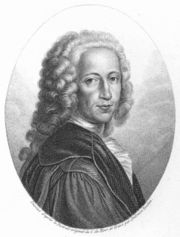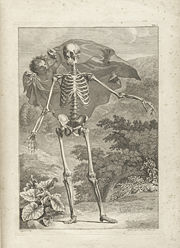
Bernhard Siegfried Albinus
Encyclopedia

Germany
Germany , officially the Federal Republic of Germany , is a federal parliamentary republic in Europe. The country consists of 16 states while the capital and largest city is Berlin. Germany covers an area of 357,021 km2 and has a largely temperate seasonal climate...
-born Dutch
Netherlands
The Netherlands is a constituent country of the Kingdom of the Netherlands, located mainly in North-West Europe and with several islands in the Caribbean. Mainland Netherlands borders the North Sea to the north and west, Belgium to the south, and Germany to the east, and shares maritime borders...
anatomist.
Albinus was born at Frankfurt (Oder)
Frankfurt (Oder)
Frankfurt is a town in Brandenburg, Germany, located on the Oder River, on the German-Polish border directly opposite the town of Słubice which was a part of Frankfurt until 1945. At the end of the 1980s it reached a population peak with more than 87,000 inhabitants...
, where his father, Bernhard Albinus (1653–1721), was professor
Professor
A professor is a scholarly teacher; the precise meaning of the term varies by country. Literally, professor derives from Latin as a "person who professes" being usually an expert in arts or sciences; a teacher of high rank...
of the practice of medicine
Medicine
Medicine is the science and art of healing. It encompasses a variety of health care practices evolved to maintain and restore health by the prevention and treatment of illness....
. In 1702 the latter was transferred to the chair of medicine at Leiden University
Leiden University
Leiden University , located in the city of Leiden, is the oldest university in the Netherlands. The university was founded in 1575 by William, Prince of Orange, leader of the Dutch Revolt in the Eighty Years' War. The royal Dutch House of Orange-Nassau and Leiden University still have a close...
, and it was there that Bernhard Siegfried began his studies in 1709, at the age of 12, having for his teachers such men as Boerhaave and Nikolaus Bidloo. Having finished his studies at Leiden, he went to Paris
Paris
Paris is the capital and largest city in France, situated on the river Seine, in northern France, at the heart of the Île-de-France region...
, where, under the instruction of Sebastien Vaillant
Sébastien Vaillant
Sébastien Vaillant was a French botanist.Vaillant was born at Vigny, Val d'Oise. He studied medicine at Pontoise, and then moved to Paris to practice as a surgeon, where he studied botany at the Jardin des Plantes under Joseph Pitton de Tournefort.Vaillant was appointed to the staff of the Jardin...
(1669–1722), Jacob Winslow
Jacob B. Winslow
Jacob B. Winsløw, also known as Jacques-Bénigne Winslow, Danish-born anatomist .- Life :Winsløw was born in Denmark, later he became a pupil and successor of Guichard Joseph Duverney, as well as a convert to Catholicism, naturalized in France, and finally became professor of anatomy at the Jardin...
(1669–1760) and others, he devoted himself especially to anatomy and botany
Botany
Botany, plant science, or plant biology is a branch of biology that involves the scientific study of plant life. Traditionally, botany also included the study of fungi, algae and viruses...
. After a year's absence he was, on the recommendation of Boerhaave, recalled in 1719 to Leiden to be a lecturer on anatomy and surgery
Surgery
Surgery is an ancient medical specialty that uses operative manual and instrumental techniques on a patient to investigate and/or treat a pathological condition such as disease or injury, or to help improve bodily function or appearance.An act of performing surgery may be called a surgical...
. Two years later he succeeded his father in the professorship of these subjects, and speedily became one of the most famous teacher
Teacher
A teacher or schoolteacher is a person who provides education for pupils and students . The role of teacher is often formal and ongoing, carried out at a school or other place of formal education. In many countries, a person who wishes to become a teacher must first obtain specified professional...
s of anatomy in Europe
Europe
Europe is, by convention, one of the world's seven continents. Comprising the westernmost peninsula of Eurasia, Europe is generally 'divided' from Asia to its east by the watershed divides of the Ural and Caucasus Mountains, the Ural River, the Caspian and Black Seas, and the waterways connecting...
, his classroom being resorted to not only by student
Student
A student is a learner, or someone who attends an educational institution. In some nations, the English term is reserved for those who attend university, while a schoolchild under the age of eighteen is called a pupil in English...
s but by many practising physician
Physician
A physician is a health care provider who practices the profession of medicine, which is concerned with promoting, maintaining or restoring human health through the study, diagnosis, and treatment of disease, injury and other physical and mental impairments...
s. In 1745 Albinus was appointed professor of the practice of medicine, being succeeded in the anatomical chair by his brother Frederick Bernhard (1715–1778), who, as well as another brother, Christian Bernhard (1700–1752), attained considerable distinction. Bernhard Siegfried, who was twice rector of his university, died at Leiden.

Petrus Camper
Peter, Pieter, or usually Petrus Camper was a Dutch physician, anatomist, physiologist, midwife, zoologist, anthropologist, paleontologist and a naturalist. He studied the orangutan, the rhinoceros, the skull of a whale...
, especially for the whimsical backgrounds added to many of the pieces by Wandelaar, but Albinus staunchly defended Wandelaar.
External links
- Bernhard Siegfried Albinus: Tabulae sceleti et musculorum corporis humani (London, 1749). Selected pages scanned from the original work. Historical Anatomies on the Web. US National Library of Medicine.

